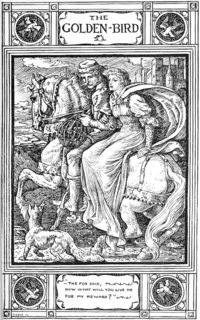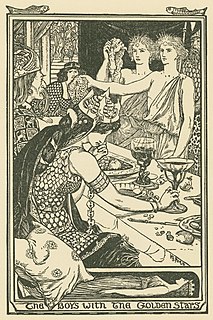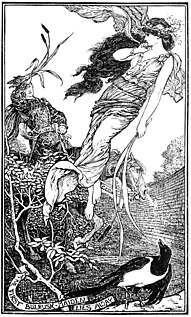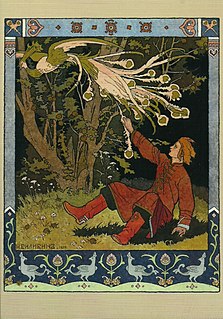
"The Golden Bird is a fairy tale collected by the Brothers Grimm about the pursuit of a golden bird by a gardener's three sons.

"The Master Maid" is a Norwegian fairy tale collected by Peter Christen Asbjørnsen and Jørgen Moe in their Norske Folkeeventyr. "Master" indicates "superior, skilled." Jørgen Moe wrote the tale down from the storyteller Anne Godlid in Seljord on a short visit in the autumn of 1842. Andrew Lang translated the tale to English and included it in his The Blue Fairy Book (1889). A later translation was made by George Dasent, in his Popular Tales from the North.

The Death of Koschei the Deathless or Marya Morevna is a Russian fairy tale collected by Alexander Afanasyev in Narodnye russkie skazki and included by Andrew Lang in The Red Fairy Book. The character Koschei is an evil immortal man who menaces young women with his magic.
How Ian Direach got the Blue Falcon is a Scottish fairy tale, collected by John Francis Campbell in Popular Tales of the West Highlands. He recorded it from a quarryman in Knockderry, Roseneath, named Angus Campbell.

The youngest son is a stock character in fairy tales, where he features as the hero. He is usually the third son, but sometimes there are more brothers, and sometimes he has only one; usually, they have no sisters.

"The Nine Peahens and the Golden Apples" is a work of Serbian epic poetry. It is classified as Aarne-Thompson type 400*, "The Swan Maiden", and ATU 400, "The Quest for the Lost Wife".

The Boys with the Golden Stars is a Romanian fairy tale collected in Rumänische Märchen. Andrew Lang included it in The Violet Fairy Book. An alternate title to the tale is The Twins with the Golden Star.
The Prince Who Worked as Satan's Servant and Saved the King from Hell is a Lithuanian fairy tale collected by German linguists August Leskien and Karl Brugmann. Andrew Lang included it in The Grey Fairy Book under the title The Magician's Horse.

Lovely Ilonka is a Hungarian fairy tale published in Ungarische Märchen by Elisabet Róna-Sklarek. Andrew Lang included it in The Crimson Fairy Book.
The Bird 'Grip' is a Swedish fairy tale. Andrew Lang included it in The Pink Fairy Book. It is Aarne-Thompson type 550, the quest for the golden bird/firebird; other tales of this type include The Golden Bird, The Greek Princess and the Young Gardener, How Ian Direach got the Blue Falcon, The Nunda, Eater of People, and Tsarevitch Ivan, the Fire Bird and the Gray Wolf.
The Little Green Frog is a French literary fairy tale, from the Cabinet des Fées. Andrew Lang included it in The Yellow Fairy Book.
{{multiple issues| King Kojata or The Unlooked for Prince or Prince Unexpected is a Slavonic fairy tale, of Polish origin. Louis Léger remarked that its source was "one of the most important collections of Polish literature".

"The Water of Life" is a German fairy tale collected by the Brothers Grimm, tale number 97.
"The Bold Knight, the Apples of Youth, and the Water of Life" is a Russian fairy tale collected by Alexander Afanasyev in Narodnye russkie skazki. The tale and is variants are numbered 171-178 in the first volume of the three-volume collection.

"Tsarevich Ivan, the Firebird and the Gray Wolf" is a Russian fairy tale collected by Alexander Afanasyev in Russian Fairy Tales.

The Greek Princess and the Young Gardener is an Irish fairy tale collected by Patrick Kennedy in Fireside Stories of Ireland. Joseph Jacobs included it in More Celtic Fairy Tales.

The Norka is a Russian fairy tale published by Alexander Afanasyev in his collection of Russian Fairy Tales, numbered 132.

"The Fairy Aurora" is a fairy tale written by Ioan Slavici and published in June 1872. Mihai Eminescu would have urged him to write this first story of his, which was read at Junimea in two sessions and was published in the magazine Convorbiri Literare.
Dawn, Twilight and Midnight or Dawn, Evening, and Midnight is a Russian fairy tale collected by Russian folklorist Alexander Afanasyev and published in his compilation Russian Fairy Tales as number 140. The tale was translated by Jeremiah Curtin and published in Fairy Tales of Eastern Europe.
The Hedgehog, the Merchant, the King and the Poor Man is a Hungarian fairy tale collected by László Merényi and translated by folklorist Jeremiah Curtin.












